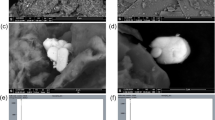Abstract
The analysis of antimony in soil is an important component in the assessment of environmental risk associated with the discharge of munitions at small arms ranges. Proficiency testing samples associated with accreditation to the ISO 17025 standard have been examined for their antimony content using Instrument Neutron Activation Analysis (INAA) and using microwave assisted in situ hydrofluoric acid or nitric acid digestion, or nitrate ashing, followed by ICP-MS analysis. Data are compared with the proficiency testing criteria associated with accreditation and with consensus data. All three techniques afford data which are consistent with accredited analyses. However, the antimony concentrations obtained are method dependant, and generally as follows; INAA > in situ HF > nitrate ashing > nitric acid. In situ HF data and nitrate ashing data are systematically higher and lower than consensus values, respectively, but within the acceptable accreditation range. INAA is the only technique which affords a concentration for antimony in the certified reference material PACS-2 (10.0 ± 0.1 μg g−1) which is not statistically different from its certified value (11.3 ± 1.3 μg g−1).
Similar content being viewed by others
References
Jenkins TF, Hewitt AD, Grant CL, Thiboutot S, Ampleman G, Walsh ME, Ranney TA, Ramsey CA, Palazzo AJ, Pennington JC (2006) Chemosphere 63:1280–1290
Ragnvaldsson D, Brochu S, Wingfors H (2007) J Hazard Mater 142:418–424
Robidoux PY, Gong P, Sarrazin M, Bardai G, Paquet L, Hawari J, Dubois C, Sunahara GI (2004) Ecotoxicol Environ Saf 58:300–313
Bennett JR, Kaufman CA, Koch I, Sova J, Reimer KJ (2007) Sci Total Environ 374:91–101
Ackermann S, Gieréa R, Newville M, Majzlana J (2009) Sci Total Environ 407:1669–1682
De Boeck M, Kirsch-Volders M, Lison D (2003) Mutat Res 533:135–152
BS EN ISO/IEC 17025 (2005) General requirements for the competence of testing and calibration laboratories. International Standards Organisation, Geneva
Kulkarni P, Chellam S, Ghurye G, Fraser MP (2003) Environ Eng Sci 20:517–531
Chattopadhyay P, Fisher AS, Henon DN, Hill SJ (2004) Microchim Acta 144:277–283
Andrews WS (1989) Thermal neutron flux mapping around the reactor core of the SLOWPOKE-2 at RMC. Master of Engineering Thesis. Royal Military College of Canada, Kingston
CALA (2010) PT program scheme revision 1.3, Ottawa. http://www.cala.ca/PT15-01-PT_Program_Scheme.pdf. Accessed 19 February 2011
CCME (2006) Canadian soil quality guidelines for the protection of environmental and human health: summary table, technical report. Canadian Council of Ministers of the Environment, Ottawa, Canada
CALA (2011) Directory of laboratories, Ottawa. http://209.90.159.196/. Accessed 19 February 2011
Nash MJ, Maskall JE, Hill SJ (2000) J Environ Monitor 2:97–109
Katayama Y, Misawa A, Yamada N, Yachi S, Muto H, Aoki T, Kawabata Y, Nagail M (2008) J Radioanal Nucl Chem 278:283–286
Serfor-Armah Y, Nyarko BJB, Adotey DK, Dampere SB, Adomako D (2006) Water Air Soil Poll 175:181–192
Acknowledgments
The use of ICP-MS instrumentation obtained by Chemical, Biological, Radiological, Nuclear, and Explosives (CBRNE) Research and Technology Initiative (CRTI) Technology Acquisition Funds is gratefully acknowledged.
Author information
Authors and Affiliations
Corresponding author
Rights and permissions
About this article
Cite this article
Kelly, D.G., Mattson, K.M., Nielsen, K.S. et al. Neutron activation analysis of antimony in soils: a comparison of NAA with digestion/ICP-MS methods and ‘consensus’ laboratory data. J Radioanal Nucl Chem 291, 89–94 (2012). https://doi.org/10.1007/s10967-011-1240-6
Received:
Published:
Issue Date:
DOI: https://doi.org/10.1007/s10967-011-1240-6




